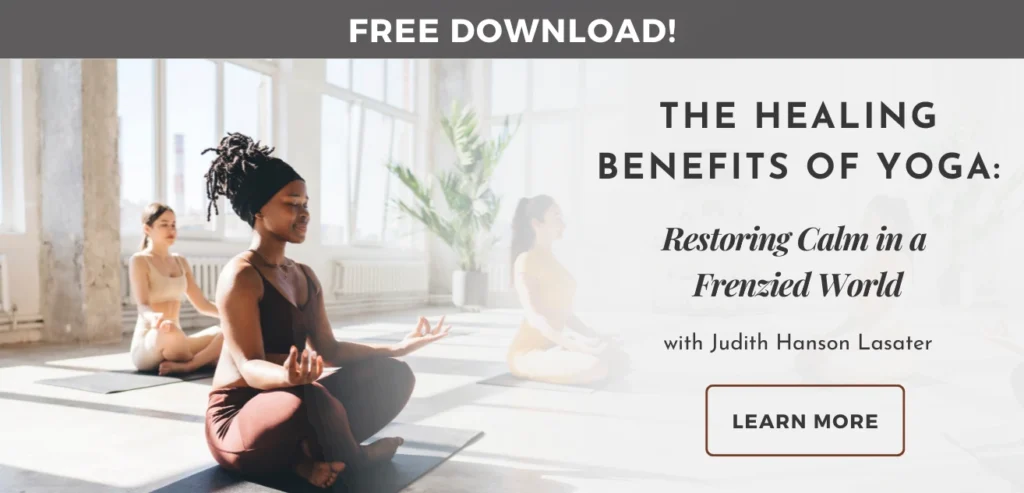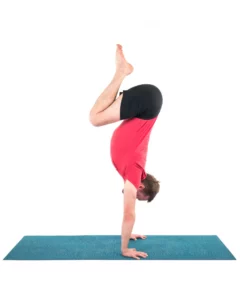Practice Tips for a Joyful Revolved Triangle Pose

Article At A Glance
Revolved Triangle Pose (Parivrtta Trikonasana) is a powerful pose with many benefits. This yoga pose can create more range of motion in the hips, hamstrings, and spine. Revolved Triangle Pose also helps improve balance and stability. It is a complicated pose and can feel challenging for many practitioners. Here are some yoga practice tips and variations for Revolved Triangle Pose.
Revolved Triangle Pose (Parivrtta Trikonasana) is a powerful pose with many benefits. This yoga pose can create more range of motion in many areas of the body, including the hips, hamstrings, and spine. Revolved Triangle Pose also helps with important stability required for everyday life. It can be challenging, and here are some yoga practice tips and variations for Revolved Triangle Pose.
Benefits of Revolved Triangle Yoga Pose
- Trains our balance
- Strengthens the legs
- Helps us connect to the earth
- Helps maintain the rotation of the spine
- Stretches the hips and hamstrings
- Strengthens the neck
- Opens the chest and shoulders
How to Practice Revolved Triangle Yoga Pose
- Start at the front of the yoga mat in Mountain Pose (Tadasana), with your hands in Prayer Pose (Anjali Mudra), or on your hips. Step your left foot about halfway back on the mat.
- The left foot can turn out a little or point more toward the front of the mat, and the heel is grounded.
- Your feet can be slightly apart, or the heels align. The most stable position for the feet is to place them hip-width apart from left to right. Resist the temptation to cross the left foot over to the right side of the mat.
- Keep your body facing the front of the mat.
- Inhale, lengthen the spine, and raise the arms overhead.
- Exhale, turn your ribcage to the right, extending your arms out to the sides at shoulder height. Allow the right side of the pelvis to draw back a bit.
- Inhaling, extend the arms and reach forward with your left hand.
- Exhale, and keeping the rotation of the spine, hinge forward. Reach your left hand toward the floor on the pinky-toe side of the foot. Feel free to place your hand on a yoga block at any height to lengthen your spine. Then, reach your right hand up toward the sky.
- Turn your head and gaze to the right hand if it is comfortable for the neck. If not, look straight ahead.
- Breathe and relax here for 5 to 10 deep breaths.
- To leave the pose, lift your torso up, rotate back to the center, and step your left foot forward.
- After a few breaths in Mountain Pose, practice your second side.
Common Challenges in Practicing Parivrtta Trikonasana in Yoga Practice 
- Focusing on placing the front hand on the ground can compromise the length of the spine, creating a hunch or slight forward fold through the shoulders. (See image right for this misalignment.)
- Allowing the back foot to lift a little while trying to rotate from the hips can destabilize the whole pose.
- Those with flexible shoulders often reach the top arm too far back. The top hand should reach to the sky rather than behind the body.
Practice Tips for Revolved Triangle Yoga Pose
To enhance the pose for each individual body, the following practice tips can help.
- Actively ground your feet and keep the same energy in both feet.
- Keep your spine long and find the rotation from the long spine, resisting the temptation to hunch in. (See misalignment in the image above.)
- Draw the front leg and hip back. This will help to stabilize the pelvis.
- Reach your hands away from each other, keeping your arms active and chest open.

Variations of Parivrtta Trikonasana
If you still find it challenging for your body with the above cues, try the following variations of Revolved Triangle Pose.
- Use a block placed on the outside of the front foot. Reach the bottom hand to the block rather than the floor. This helps keep length in the spine. (see image above) (with a chair see image below)
- Place the block, or your hand, on the inside of the front foot to ease any need to hunch or forward fold.
- Shorten the stance or distance between your feet if you find it difficult to keep the back heel grounded.
- Keep your top hand on your hip rather than reaching up to the sky if your shoulder is unstable.

Also, read...
Stand Firm: 6 Easy Balancing Moves for Your Daily Yoga Routine
The Many Benefits of Twists: 5 Great Yoga Postures for Low Back Health
Desk-Friendly Yoga Neck and Shoulder Stretches
Related courses

Erin Bourne (RYT500, YACEP) is a yoga teacher and yoga teacher trainer based in Seventeen Seventy (yes, the real town name) in Australia. She also teaches Pilates and other movement modalities; having come to yoga from an Exercise Science and education background, she is obsessed with learning and sharing about the body and movement. Erin shares her experience and knowledge through regular classes, teacher trainings, online courses, and writing. Her course offerings include 3D Anatomy and Resistance Yoga. Her writing includes the book A Yogi’s Guide to Fascia and numerous print and online published articles. You can find Erin’s creations through her website http://www.erinlbourne.com/





